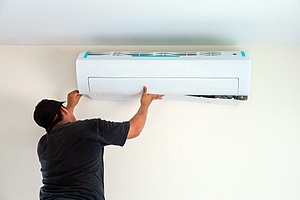Presidential Heating & Air Conditioning
Gaithersburg HVAC Contractors
Share
Share on FacebookTweet
Tweet this0Share
Share on LinkedIn0 shares on LinkedIn It is never convenient when your AC stops working. Despite your best efforts to keep it well maintained, unexpected problems can occur. After about ten years, your AC will likely be less efficient than in the past, and the chances of it breaking down tend to increase. So what do you do if your AC stops working?
It is never convenient when your AC stops working. Despite your best efforts to keep it well maintained, unexpected problems can occur. After about ten years, your AC will likely be less efficient than in the past, and the chances of it breaking down tend to increase. So what do you do if your AC stops working?
We have some tips that you can try if you find yourself in this situation. You may want to take these steps before you call a professional to rule out some potential reasons your air conditioner is experiencing problems or stopped working. Let’s get into it.
7 Steps to Take If Your AC Stops Working
It can be very frustrating if your AC stops working in the middle of the summer. If it breaks down, you want to get it up and running as soon as possible. You might be able to troubleshoot your A/C to determine what’s wrong. Here are seven steps that you can try when your AC isn’t working:
#1 Inspect Your Condenser
The first thing you will typically want to check when your A/C stops working is the condenser, which is installed outside the home. As simple as it sounds, make sure it is plugged in properly. If it seems to be running, then go back inside to check your thermostat. Verify that it is set at the right temperature to kick your A/C into gear.
#2 Reduce the Temperature
To continue testing your A/C, turn down the temperature on the thermostat. Decrease the thermostat settings by five to ten degrees. Sometimes thermostats can be a little temperamental. You might want to go through and read your thermostat manual for details on its proper operation.
There are a few little things that might affect the way it works. If you have a faulty thermostat, then you can get it fixed or replaced. That’s much less expensive and easier to deal with than replacing or repairing your A/C unit.
If you noticed that your thermostat doesn’t appear to be on, then you might need to replace the batteries. That’s usually the reason why a thermostat has a blank screen and is easy enough to fix on your own. Replace the batteries and check your A/C unit again to see if it works once you have set it.
Another simple check on your thermostat is to make sure that it’s set to “cool.” If you’re just changing seasons or having some extreme weather changes, the problem might just be that it’s on the “heat” setting or you’re running only the fan.
#3 Inspect the Fuse Box
Sometimes your problem is as simple as a tripped circuit breaker or a blown fuse. You should definitely check your fuse box if your A/C stops working to rule it out. If one of your breakers is tripped, it’s possible that it’s the one for your HVAC system. Try resetting it, and then see if your A/C will start working.
A blown fuse that connects your A/C and thermostat will cause your A/C to stop working. It’s a lot like the situation that occurs if your car has a bad battery. This type of issue requires some special training, so call a heating and cooling company to address it.
#4 Make Sure Your Filter Is Not Dirty
Regularly cleaning and changing your air filter is necessary to keep your A/C running properly. Typically an air filter needs to be replaced or cleaned every three months, but check your manufacturer’s instructions for more details. If your filter is dirty, it will get dust and other gunk clogged up in your HVAC system, which will restrict the airflow.
When your A/C doesn’t have the airflow it needs, the system won’t cool properly. It will stop working. Your coil will start to form ice around it, causing it to freeze up. Refrigerant leaks, an improper refrigerant charge, obstructed supply or return vents, and closed supply vents could be other reasons your coil freezes. If you have a frozen coil, then see if it works once the ice melts. If not, you should call a service expert. Your coil might need something within it to be replaced.
The most common reason is a dirty air filter, but keep these other potential reasons in mind.
#5 Check For Disconnect Switches
Your A/C unit has an indoor and outdoor disconnect switch that’s installed next to it. Check and make sure that these aren’t switched off for some reason. Your indoor disconnect switch may have been turned off accidentally by someone bumping into it, especially if it’s in a garage or attic.
#6 Check to See If Your A/C Has Debris Around It
There is something else that’s going on if your A/C is turning on but not blowing cold air. Check outside and make sure there’s no leaves or other debris blocking the unit. Clear away anything that’s in the way and try it again.
#7 Schedule a Repair
If you have tried all these steps and you didn’t resolve the problem with your A/C, it’s time to call in an expert. The problem is probably too complicated to fix on your own. A certified heating and cooling specialist can inspect your A/C and run other diagnostics to determine what the problem is.
Contact AC Repair Specialists Today
Presidential Heating & Air Conditioning is here to assist you with your heating and cooling needs. Schedule a consultation today to get started.


